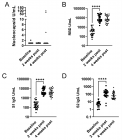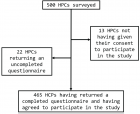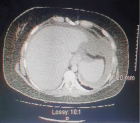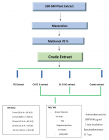Abstract
Research Article
Effect of storage period on the quality characteristics of two varieties of African Mango Seed Flour at ambient temperature
Adedeji TO*
Published: 10 August, 2017 | Volume 1 - Issue 1 | Pages: 012-019
The effects of storage of Ogbona seed flour (Irivingia gabonensis and Irivingia excelsa), at ambient condition (30±20C, 65-74% RH) for 0-4 months on some physical characteristics were investigated. The samples were subjected to storage in air tight polyethylene bags for up to four months. Samples were removed at intervals of 0, 1, 2, 3 and 4 months for analysis. The chemical: proximate constituents, free-fatty acids and peroxide values; selected functional properties: water/oil absorption capacity, foam capacity and viscosity and sensory attributes of the samples were investigated. The result shows that there was no observable change in the chemical composition, selected functional and sensory properties of the two varieties of Ogbona seed flours when stored up to two months but decreased from third to fourth month during storage at ambient temperature. Therefore, storage at ambient temperature (30±20C, 65-74% RH) could extend the shelf life of the samples for up to two months in air-tight polyethylene bags of 0.7mm thickness without losing its quality characteristics.
Read Full Article HTML DOI: 10.29328/journal.afns.1001002 Cite this Article Read Full Article PDF
Keywords:
Ogbono; Storage; Functional; Sensory; Properties
References
- Harris DJ. A revision of the Irvingiacea in Africa. Bulletin du Jardin Botanique National de Belgique. 1996; 65: 143-196. Ref.: https://goo.gl/noKWpy
- Ndoye O, Pérez MR, Eyebe A. The markets of non-timber forest products in the humid zone of Cameroon. Ref.: https://goo.gl/tc9C5R
- Leakey R, Schrecheriberg K, Tchoundjev Z. The participatory domestication of West African indigenous fruits. Int For Rev. 2003; 5: 338-347. Ref.: https://goo.gl/XshcMS
- Okafor JC. Selection and improvement of indigenous tropical fruit tree: Problems and prospects. J Forest Res. 1985; 1: 87-95. Ref.: https://goo.gl/oL9C4K
- Okafor JC. Improving edible species of forest products. Unasylva. 1991; 165: 17-23. Ref.: https://goo.gl/wQSe7M
- Okafor JC, Ejkiofor M, Okolo HC. Development and utilisation of disappearing and under 7536. Biodiversity Support Programme. WWF, Washington, D.C.
- Leakey RRB. Farmers top priority fruit trees. Agris. 1999; 11: 11-15. Ref.: https://goo.gl/oRCAQe
- Koyejo AO, Omokhua G. Propagation studies on Irvingia wombulu (syn.Excelsa) Ex. Okafor and agroforestry specis. In: Proceedings of FAN Conference held in Abuja. 2001; 183-187.
- Matos L, Nzikou JM, Matouba E, Pandzou-Yembe VN, Mapepoulou TG, et al. Studies of Irvingia gabonensis seeds kernels: Oil technological applications. Pak J Nutr. 2009; 8: 151-157. Ref.: https://goo.gl/5EFFa4
- Lowe AJ, Gillies ACM, Wilson J, Dawson IK. Conservation genetics of bush mango from central/west Africa: Implications from random amplified polymorphic DNA analysis. Mol Ecol. 2000; 9: 831-841. Ref.: https://goo.gl/DGgg39
- Fayemi PO. Nigerian Vegetables. Heinemann Educational Books (Nigeria) Plc. 1999; 12-36. Ref.: https://goo.gl/kD3Fsn
- Atangana AR, Techoundjeu Z, Foldout JM, Asaah E, Dumb M, et al. Domestication of Irvingia gabonensis: 1. phenotypic variation in fruit and kernels in two population from Cameroon. Agrioforestory System. 2001; 53: 55-64. Ref.: https://goo.gl/QEEtFn
- Akusu MO, Kiin-Kabari DB. Effect of storage period on selected functional, chemical stability and sensory properties of bush mango (Irvingia gabonensis) seed flour. African Journal of Food Science and Technology. 2013; 4: 136-140. Ref.: https://goo.gl/QmfaK7
- Hyman EL. Technology and the organization of production processing and marketing of non-timber forest products. 1995; 197-199. Ref.: https://goo.gl/xgUUgK
- Egan H, Kirk RS, Sawyer, R. Pearson’s chemical analysis of foods (8thed.). 1981; 591. Ref.: https://goo.gl/HTDsnq
- Official Methods of Analysis of AOAC International, 20th Edition. 2016. Ref.: https://goo.gl/ayrNc4
- Fleming SE, Soculski FW, Hamon NW. Gelation and thickening phenomena of vegetable protein Products. J Food Sci. 1975; 40: 805-807. Ref.: https://goo.gl/pRvrQc
- Coffmann CW, Garciaj VV. Functional properties and amino acid content of a protein isolate from mung bean flour. J Food Tech. 1977; 12: 473-484. Ref.: https://goo.gl/x6t59r
- Beuchart LR. Functional and electrophoretic characteristics of succinylated peanut flour protein. J Agric Food Che. 1977; 25: 258-261. Ref.: https://goo.gl/b3kcet
- Iwe MO. Handbook of sensory methods and analysis. Re-joint Communications Services Ltd. 2010; 75-78. Ref.: https://goo.gl/nZGDG5
- Schippers RR. African Indogenous Vegetables.An Overview of the Cultivated Species. Department for International Development. 2010; 103-118. Ref.: https://goo.gl/f9LzgK
- lhekoronye Al, Ngoddy PO. Integrated Food Science and Technology for the Tropics. 1985; 386. Ref.: https://goo.gl/u4vdXW
- Braverman JBS. Introduction to the Biochemistry of Foods. 1991. Ref.: https://goo.gl/XdYtv3
- Idowu MA, Akindele SA. Effect of storage of cassava roots on the chemical composition and sensory qualities of gari and fifu. Food Chem. 1994; 51: 421-424. Ref.: https://goo.gl/uHCbah
- Osagie AU, Onigbinde AO. Effects of growth, maturation and storage onthe composition of plant foods. In: Nutritional Quality of Plant Foods.Post-harvest Research Unit. 1999-220.
- Erickson MA. Lipid oxidation: flavour and nutritional quality deterioration in frozen foods. Quality in frozen food. 1997; 141-173. Ref.: https://goo.gl/Qy6uDg
- Fellows PJ. Food Processing Technology: Principles and practice. Woodhead publishing. Ref.: https://goo.gl/1DUJX8
- Uzo TO, Ojiakor UU. A physical method for measuring fruit quality. J Food Sri. 1998; 45: 310-315.
- Cardello AV. Perception of food quality ln: I.A Taub and R.P Singh (eds). Food storage stability. CRC Press. 1998; 1-38. Ref.: https://goo.gl/avE6F3
- Ngondi JL, Oben JE, Minka SR. The effect of Irvingia gabonensis seeds on body weight and blood lipids of obese subjects in Cameroon. Lipids in health and Disease. 2005; 4: 12-15. Ref.: https://goo.gl/d1rUz9
- Leakey RRB, Fondoun JM, Atangana A, Tchoundjeu Z. Quantitative descriptors of variation in the fruits and seeds of Irvingia gabonensis. Agrofor, 2000; 50: 47-58. Ref.: https://goo.gl/kk6v1Z
Figures:
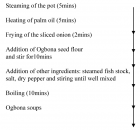
Figure 1
Similar Articles
-
Effect of storage period on the quality characteristics of two varieties of African Mango Seed Flour at ambient temperatureAdedeji TO*. Effect of storage period on the quality characteristics of two varieties of African Mango Seed Flour at ambient temperature. . 2017 doi: 10.29328/journal.afns.1001002; 1: 012-019
-
Effect of pre-treatments and drying methods on Moisture percentage of dried Tomato SlicesPokharkar KK*,Delvadia DV,Jadhav Parag B,Bhor PB. Effect of pre-treatments and drying methods on Moisture percentage of dried Tomato Slices. . 2017 doi: 10.29328/journal.afns.1001004; 1: 024-026
-
Effect of drying methods on the physicochemical properties and Fatty Acid composition of Moringa Seeds OilIbrahim TA*,Oloye DA,Omosuli SV. Effect of drying methods on the physicochemical properties and Fatty Acid composition of Moringa Seeds Oil . . 2017 doi: 10.29328/journal.afns.1001005; 1: 027-032
-
Anti-nutrient and mineral properties of Complementry Food produced from Malted Red Sorgum and Defatted Soybean Flour BlendOloye DA*,Agbaje RB,Olatunji CA,Olawale-Olakunle OE. Anti-nutrient and mineral properties of Complementry Food produced from Malted Red Sorgum and Defatted Soybean Flour Blend. . 2017 doi: 10.29328/journal.afns.1001006; 1: 033-038
-
Effect of Pre-Treatments and Drying Methods on the Chemical Quality and Microbial Density of Wild Edible Oyster MushroomIbrahim TA*,Adaramola-Ajibola KM,Adesuyi AT,Olanrewaju SO,Akinro EB. Effect of Pre-Treatments and Drying Methods on the Chemical Quality and Microbial Density of Wild Edible Oyster Mushroom. . 2017 doi: 10.29328/journal.afns.1001007; 1: 039-044
-
Chemical composition and organoleptic properties of Cocoyam starch-wheat flour blend noodlesAdedeji Temileye Omotayo*. Chemical composition and organoleptic properties of Cocoyam starch-wheat flour blend noodles. . 2017 doi: 10.29328/journal.afns.1001009; 1: 058-062
-
Development and quality evaluation of Jam from Watermelon (Citrullus Lanatus) and Pawpaw (Carica Papaya) juiceAdedeji Temileye Omotayo*. Development and quality evaluation of Jam from Watermelon (Citrullus Lanatus) and Pawpaw (Carica Papaya) juice. . 2017 doi: 10.29328/journal.afns.1001010; 1: 063-071
-
Bioactive components of teaGargi Sena*,Moutusi Nath,Nilanjan Sarkar,Subhasis Maity. Bioactive components of tea. . 2020 doi: 10.29328/journal.afns.1001020; 4: 001-009
-
Effect of ginger flour supplementation on fermented millet flour ‘ibyer’ anti-diabetic and biochemical propertiesOgori AF*,Adakole MI,Ikya JK,Girgih AT,Upev V. Effect of ginger flour supplementation on fermented millet flour ‘ibyer’ anti-diabetic and biochemical properties. . 2020 doi: 10.29328/journal.afns.1001025; 4: 029-035
-
Agaricus brasiliensis (Sun mushroom) and its therapeutic potential: A reviewAline Mayrink de Miranda*. Agaricus brasiliensis (Sun mushroom) and its therapeutic potential: A review. . 2022 doi: 10.29328/journal.afns.1001032; 6: 006-015
Recently Viewed
-
Gilbert’s Syndrome Revealed by Hepatotoxicity of ImatinibImen Ben Amor*,Imen Frikha,Moez Medhaffer,Moez Elloumi. Gilbert’s Syndrome Revealed by Hepatotoxicity of Imatinib. Ann Clin Gastroenterol Hepatol. 2025: doi: 10.29328/journal.acgh.1001049; 9: 001-003
-
The pathogenesis of psoriasis: insight into a complex “Mobius Loop” regulation processYuankuan Jiang,Haiyang Chen,Jiayue Liu,Tianfu Wei,Peng Ge,Jialin Qu*,Jingrong Lin. The pathogenesis of psoriasis: insight into a complex “Mobius Loop” regulation process. Arch Pathol Clin Res. 2021: doi: 10.29328/journal.apcr.1001024; 5: 020-025
-
Potential Use of Essential Oils and Their Individual Components in Cosmeceuticals: A ReviewHamdy A Shaaban*. Potential Use of Essential Oils and Their Individual Components in Cosmeceuticals: A Review. Ann Biomed Sci Eng. 2023: doi: 10.29328/journal.abse.1001023; 7: 031-037
-
Studies on some spices and herbs: Chemical composition, health benefits and functional propertiesHamdy A Shaaban*. Studies on some spices and herbs: Chemical composition, health benefits and functional properties. Ann Biomed Sci Eng. 2023: doi: 10.29328/journal.abse.1001019; 7: 001-011
-
About Efficiency of High-order Harmonic Generation in Attosecond PhysicsAng-Yang Yu*. About Efficiency of High-order Harmonic Generation in Attosecond Physics. Int J Clin Virol. 2024: doi: 10.29328/journal.ijcv.1001061; 8: 045-047
Most Viewed
-
Evaluation of Biostimulants Based on Recovered Protein Hydrolysates from Animal By-products as Plant Growth EnhancersH Pérez-Aguilar*, M Lacruz-Asaro, F Arán-Ais. Evaluation of Biostimulants Based on Recovered Protein Hydrolysates from Animal By-products as Plant Growth Enhancers. J Plant Sci Phytopathol. 2023 doi: 10.29328/journal.jpsp.1001104; 7: 042-047
-
Sinonasal Myxoma Extending into the Orbit in a 4-Year Old: A Case PresentationJulian A Purrinos*, Ramzi Younis. Sinonasal Myxoma Extending into the Orbit in a 4-Year Old: A Case Presentation. Arch Case Rep. 2024 doi: 10.29328/journal.acr.1001099; 8: 075-077
-
Feasibility study of magnetic sensing for detecting single-neuron action potentialsDenis Tonini,Kai Wu,Renata Saha,Jian-Ping Wang*. Feasibility study of magnetic sensing for detecting single-neuron action potentials. Ann Biomed Sci Eng. 2022 doi: 10.29328/journal.abse.1001018; 6: 019-029
-
Pediatric Dysgerminoma: Unveiling a Rare Ovarian TumorFaten Limaiem*, Khalil Saffar, Ahmed Halouani. Pediatric Dysgerminoma: Unveiling a Rare Ovarian Tumor. Arch Case Rep. 2024 doi: 10.29328/journal.acr.1001087; 8: 010-013
-
Physical activity can change the physiological and psychological circumstances during COVID-19 pandemic: A narrative reviewKhashayar Maroufi*. Physical activity can change the physiological and psychological circumstances during COVID-19 pandemic: A narrative review. J Sports Med Ther. 2021 doi: 10.29328/journal.jsmt.1001051; 6: 001-007

HSPI: We're glad you're here. Please click "create a new Query" if you are a new visitor to our website and need further information from us.
If you are already a member of our network and need to keep track of any developments regarding a question you have already submitted, click "take me to my Query."






